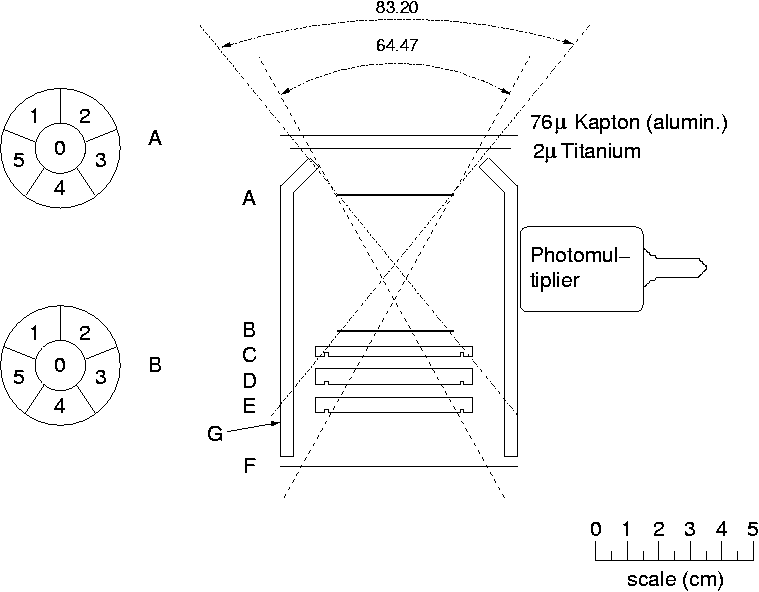 |
| Chandra EPHIN sensor schematic (adapted from SOHO version at http://www.ieap.uni-kiel.de/et/ag-heber/costep/images/figures/ephin_sensor_fig1.gif). The Chandra version has a thicker aluminized Kapton foil (76 µm) than the SOHO version |
 |
| Chandra EPHIN sensor schematic (adapted from SOHO version at http://www.ieap.uni-kiel.de/et/ag-heber/costep/images/figures/ephin_sensor_fig1.gif). The Chandra version has a thicker aluminized Kapton foil (76 µm) than the SOHO version |
EPHIN particle channels are defined by requiring coincidences in two or more of the detectors; all channels require a signal in both the A and B detectors. The segmentation of the A and B detectors allows for the reduction of the area solid-angle product by switching off the ring segments.
| Type | Name | Energy Range | Multiplicity | Priority Buffer Depth | Coincidence Condition | Geometric Factor Large [Small] (cm2 sr) |
|---|---|---|---|---|---|---|
| Electron | E150 | 0.25 - 0.70 MeV | 1 | 4 | A0 |
0.25 [0.01] |
| E300 | 0.67 - 3.0 MeV | 1 | 4 | A0 |
1.78 [0.14] | |
| E1300 | 2.64 - 6.18 MeV | 1 | 4 | A0 |
2.01 [0.12] | |
| E3000 | 4.80 - 10.4 MeV | 1 | 4 | A0 |
1.58 [0.09] | |
| Proton | P4 | 5.0 - 8.3 MeV | 3 | 4 | A1 |
5.14 [0.18] |
| P8 | 8.3 - 25.0 MeV | 3 | 4 | A1 |
5.14 [0.18] | |
| P25 | 25.0 - 41.0 MeV | 3 | 4 | A1 |
4.77 [0.18] | |
| P41 | 41.0 - 53.0 MeV | 3 | 4 | A1 |
3.80 [0.18] | |
| Helium | H4 | 5.0 - 8.3 MeV/N | 4 | 40 | A4 B0 |
5.14 [0.18] |
| H8 | 8.3 - 25.0 MeV/N | 4 | 16 | A3 B0 C0 |
5.14 [0.18] | |
| H25 | 25.0 - 41.0 MeV/N | 4 | 4 | A2 B0 C0 D0 |
4.77 [0.18] | |
| H41 | 41.0 - 53.0 MeV/N | 4 | 4 | A2 B0 C0 D0 E0 |
3.80 [0.18] | |
| Integral | INT | e- > 8.7 MeV | 1 | 0 | A0 B0 C0 D0 E0 F0 |
6.85 [0.36] |
| p+ > 53.0 MeV | ||||||
| He+ > 53.0 MeV/N |
| Detector | Type | Thickness (µm) | Resolution (keV) | Rad. Source |
|---|---|---|---|---|
| A | PIPS | 150 | 13 | 133Ba |
| B | PIPS | 300 | 26 | 241Am |
| C | Si(Li) | 3000 | 43 | 207Bi |
| D | Si(Li) | 5000 | 43 | 207Bi |
| E | Si(Li) | 5000 | 41 | 207Bi |
| Detector | Dead layerspec (µm) | meas. alpha E (MeV) | dead layer E loss (MeV) | Dead layermeas (µm) |
|---|---|---|---|---|
| C | 40 | 1.82 | 3.65 | 22 |
| D | 40 | 0.60 | 4.87 | 26 |
| E | 40 | 2.40 | 3.07 | 19 |
| Detector | Threshold (keV) | Mean (keV) | RMS (keV) | Peak (keV) | FWHM (keV) |
|---|---|---|---|---|---|
| A | 30 | 52 | 23 | 41 | 21 |
| B | 60 | 106 | 43 | 86 | 37 |
| C | 359 | 1150 | 326 | 980 | 310 |
| D | 581 | 1890 | 485 | 1620 | 490 |
| E | 582 | 1150 | 377 | 970 | 350 |
Last modified: Mon Feb 4 16:00:03 EST 2002
Dr. Michael Juda
Harvard-Smithsonian Center for Astrophysics
60 Garden Street, Mail Stop 70
Cambridge, MA 02138, USA
Ph.: (617) 495-7062
Fax: (617) 495-7356
E-mail:
mjuda@cfa.harvard.edu